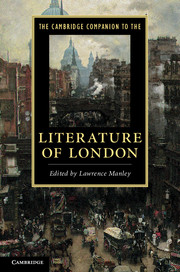Book contents
- Frontmatter
- Introduction
- 1 Images of London in medieval English literature
- 2 London and the early modern stage
- 3 London and the early modern book
- 4 London and poetry to 1750
- 5 Staging London in the Restoration and eighteenth century
- 6 London and narration in the long eighteenth century
- 7 London and nineteenth-century poetry
- 8 London in the Victorian novel
- 9 London in Victorian visual culture
- 10 London in poetry since 1900
- 11 London and modern prose, 1900-1950
- 12 Immigration and postwar London literature
- 13 Writing London in the twenty-first century
- 14 Inner London
- Guide to further reading
- Index
7 - London and nineteenth-century poetry
Published online by Cambridge University Press: 28 September 2011
- Frontmatter
- Introduction
- 1 Images of London in medieval English literature
- 2 London and the early modern stage
- 3 London and the early modern book
- 4 London and poetry to 1750
- 5 Staging London in the Restoration and eighteenth century
- 6 London and narration in the long eighteenth century
- 7 London and nineteenth-century poetry
- 8 London in the Victorian novel
- 9 London in Victorian visual culture
- 10 London in poetry since 1900
- 11 London and modern prose, 1900-1950
- 12 Immigration and postwar London literature
- 13 Writing London in the twenty-first century
- 14 Inner London
- Guide to further reading
- Index
Summary
So he who wishes to see a Vision, a perfect Whole,
Must see it in its Minute Particulars ...
William Blake, Jerusalem
I asked him whether there was a great fire anywhere? For the streets were so full of dense brown smoke that scarcely anything was to be seen. 'Oh dear no, miss', he said. 'This is a London particular.'
Mr Guppy, explaining a London fog to Esther Summerson, in Charles Dickens, Bleak House
In the nineteenth century London became the greatest city in the world; it also became largely invisible - at least for poets. The 'Minute Particulars' that for Blake enabled vision had been buried under a grimy blizzard of soot, smoke, and damp known as 'a London particular', a dense fog whose persistence grew along with the city's population and pollution. While the sun never set on the British empire, it sometimes never rose on its capital - for a week at a time, as Ruskin noted in The Storm Cloud of the Nineteenth Century (1884). Like Blake and many of his contemporaries, Ruskin placed a premium on vision: ‘To see clearly is poetry, prophecy, and religion, – all in one’, he memorably asserted in Modern Painters (1843). But what to do when circumstances – both cultural and climatic – hinder your taking a good look at your subject? This essay suggests that Romantics and Victorians struggled to represent the city for two interconnected reasons: a figurative, ‘mind-forg’d’ aversion and a literally obscured perspective. For not only was the city in its obstreperous plenitude and ceaseless mobility resistant to efforts to view it poetically, it was also quite simply hard to see, thanks to fog, smoke, and darkness.
- Type
- Chapter
- Information
- The Cambridge Companion to the Literature of London , pp. 119 - 141Publisher: Cambridge University PressPrint publication year: 2011
- 4
- Cited by

